What is Xelstrym?
Xelstrym is a central nervous system (CNS) stimulant prescription medicine used for the treatment of Attention-Deficit Hyperactivity Disorder (ADHD) in adults and children 6 years of age and older. Xelstrym may help increase. attention and decrease impulsiveness and hyperactivity in adults and children 6 years of age and older with ADHD.
It is not known if Xelstrym is safe and effective in children under 6 years of age.
Xelstrym is a federally controlled substance (CII) because it contains dextroamphetamine that can be a target for people who abuse prescription medicines or street drugs. Keep Xelstrym in a safe place to protect it from theft. Never give your Xelstrym to anyone else, because it may cause death or harm them. Selling or giving away Xelstrym may harm others and is against the law.
What is the most important information I should know about Xelstrym?
Xelstrym may cause serious side effects, including:
- Abuse and dependence. Xelstrym, other amphetamine containing products, and methylphenidate have a high chance for abuse and may cause physical and psychological dependence. Your healthcare provider should check you or your child for signs of abuse and dependence before and during treatment with Xelstrym.
- Tell your healthcare provider if you or your child have ever abused or been dependent on alcohol, prescription medicines, or street drugs.
- Your healthcare provider can tell you more about the differences between physical and psychological dependence and drug addiction.
- Heart-related problems, including:
- sudden death, stroke, and heart attack in adults
- sudden death in children who have heart problems or heart defects
- increased blood pressure and heart rate
Your healthcare provider should check you or your child carefully for heart problems before starting treatment with Xelstrym. Tell your healthcare provider if you or your child have any heart problems, heart defects, high blood pressure, or a family history of these problems.
Your healthcare provider should check your or your child’s blood pressure and heart rate regularly during treatment with Xelstrym.
Call your healthcare provider or go to the nearest hospital emergency room right away if you or your child have any signs of heart problems such as chest pain, shortness of breath, or fainting during treatment with Xelstrym.
- Mental (psychiatric) problems, including:
- new or worse behavior and thought problems
- new or worse bipolar illness
- new psychotic symptoms (such as hearing voices, or seeing or believing things that are not real) or new manic symptoms
Tell your healthcare provider about any mental problems you or your child have or about a family history of suicide, bipolar illness, or depression.
Call your healthcare provider right away if you or your child have any new or worsening mental symptoms or problems during treatment with Xelstrym, especially hearing voices, seeing or believing things that are not real, or new manic symptoms.
Who should not use Xelstrym?
Do not use Xelstrym if you or your child are:
- allergic to amphetamine products or any of the ingredients in Xelstrym. See below for a complete list of ingredients in Xelstrym.
- taking or have taken within the past 14 days a medicine called a monoamine oxidase inhibitor (MAOI), including the antibiotic linezolid or the intravenous medicine called methylene blue.
What should I tell my healthcare provider before using Xelstrym?
Before using Xelstrym, tell your healthcare provider about all medical conditions, including if you or your. child:
- have heart problems, heart defects, or high blood pressure
- have mental problems including psychosis, mania, bipolar illness, or depression or have a family history of suicide, bipolar illness, or depression
- have circulation problems in fingers and toes
- have kidney problems. Your healthcare provider may lower your dose.
- are pregnant or plan to become pregnant. It is not known if Xelstrym will harm the unborn baby.
- There is a pregnancy registry for females who are exposed to Xelstrym during pregnancy. The purpose of the registry is to collect information about the health of females exposed to Xelstrym and their babies. If you or your child becomes pregnant during treatment with Xelstrym, talk to your healthcare provider about registering with the National Pregnancy Registry for Psychiatric Medications at 1-866-961-2388 or visit online at https://womensmentalhealth.org/clinical-and-research-programs/pregnancyregistry/othermedications/.
- are breastfeeding or plan to breastfeed. Xelstrym passes into breast milk. You or your child should not breastfeed during treatment with Xelstrym. Talk to your healthcare provider about the best way to feed the baby during treatment with Xelstrym.
Tell your healthcare provider about all the medicines that you or your child take, including prescription and over the-counter medicines, vitamins, and herbal supplements.
Xelstrym may affect the way other medicines work and other medicines may affect how Xelstrym works. Using Xelstrym with other medicines may cause serious side effects. Sometimes the doses of other medicines will need to be changed while using Xelstrym.
Especially tell your healthcare provider if you or your child take:
- selective serotonin reuptake inhibitors (SSRIs)
- medicines used to treat migraine headaches called triptans
- lithium
- tramadol
- buspirone
- serotonin norepinephrine reuptake inhibitors (SNRIs)
- tricyclic antidepressants
- fentanyl
- tryptophan
- St. John’s Wort
Your healthcare provider will decide whether Xelstrym can be used with other medicines. Do not start any new medicine during treatment with Xelstrym without talking to your healthcare provider first.
How should I use Xelstrym?
- See the detailed “Instructions for Use” that comes with Xelstrym information about the right way to apply, remove, and dispose of Xelstrym.
- Your healthcare provider may change the dose if needed.
- Apply 1 Xelstrym patch at a time for not more than 9 hours. Use only 1 Xelstrym per 24 hours and change the site of application when applying a new patch.
- Apply the Xelstrym patch 2 hours before the effect is needed and remove Xelstrym within 9 hours after application.
- Your healthcare provider may sometimes stop Xelstrym treatment for a while to check ADHD symptoms.
If you or your child use too much Xelstrym, call your healthcare provider or poison control center at 1-800-222-1222 or go to the nearest hospital emergency room right away.
What should I avoid while using Xelstrym?
- Do not drive, operate heavy machinery, or do other potentially dangerous activities until you know how Xelstrym affects you.
- After applying the Xelstrym patch, avoid exposing the application site to direct external heat sources, such as hair dryers, heating pads or electric blankets, heat lamps, saunas, hot tubs, and heated water beds. Exposure to heat can cause too much medicine to pass into your body and cause serious side effects.
What are the possible side effects of Xelstrym?
Xelstrym may cause serious side effects, including:
- See “What is the most important information I should know about Xelstrym”
- Slowing of growth (weight and height) in children. Children should have their height and weight checked often. during treatment with Xelstrym. Your healthcare provider may stop the treatment with Xelstrym if your child is. not growing or gaining height or weight as expected.
- Circulation problems in fingers and toes (peripheral vasculopathy, including Raynaud's phenomenon):
- fingers or toes may feel numb, cool, painful
- fingers or toes may change color from pale, to blue, to red
Tell your healthcare provider if you or your child have numbness, pain, skin color change, or sensitivity to temperature in your fingers or toes.
Call your healthcare provider right away if you or your child have any signs of unexplained wounds appearing on fingers or toes during treatment with Xelstrym.
- Serotonin Syndrome. A potentially life-threatening problem called serotonin syndrome may happen when Xelstrym is used with certain other medicines. See "What should I tell my healthcare provider before taking Xelstrym?" Stop using Xelstrym and call your healthcare provider or go to the nearest hospital emergency room right away if you or your child develop any of the following signs and symptoms of serotonin syndrome:
- agitation
- confusion
- fast heartbeat
- dizziness
- flushing
- tremors, stiff muscles, or muscle twitching
- seizures
- seeing or hearing things that are not real (hallucination)
- coma
- changes in blood pressure
- sweating
- high body temperature (hyperthermia)
- loss of coordination
- nausea, vomiting, diarrhea
- Allergic skin rash (contact sensitization). Stop using Xelstrym and tell your healthcare provider right away if you or your child develop swelling or blisters at or around the application site. You may have a skin allergy to Xelstrym. People who have skin allergies to Xelstrym may develop an allergy to all amphetamine containing products, even amphetamine products that are taken by mouth.
- Application site reactions have happened with Xelstrym while wearing the Xelstrym patch, and after removal of the patch. Signs and symptoms of an application site reaction include, pain, Itching, burning feeling, redness, discomfort, or swelling at the application site. Call your healthcare provider if you or your child develop any application site reactions that do not resolve on their own.
The most common side effects of Xelstrym include:
- decreased appetite
- headache
- trouble sleeping
- muscle twitching (tics)
- stomach pain
- vomiting
- nausea
- irritability
- increased blood pressure
- increased heart rate
These are not all the possible side effects of Xelstrym.
Call your doctor for medical advice about side effects. You may report side effects to FDA at 1-800-FDA-1088.
General information about the safe and effective use of Xelstrym
Medicines are sometimes prescribed for purposes other than those listed in a Medication Guide. Do not use Xelstrym for a condition for which it was not prescribed. Do not give Xelstrym to other people, even if they have the same symptoms that you have. It may harm them and it is against the law. You can ask your healthcare provider or pharmacist for information about Xelstrym that is written for healthcare professionals.
How should I store Xelstrym?
- Store Xelstrym at room temperature between 68°F to 77°F (20°C to 25°C).
- Store Xelstrym in a safe place, like a locked cabinet.
- Protect Xelstrym from light and moisture.
- Keep Xelstrym in their unopened pouches until you are ready to use them.
- Dispose of remaining unused or expired Xelstrym by a medication take-back program at authorized collection sites such as retail pharmacies, hospital or clinic pharmacies, and law enforcement locations. If no take-back program or authorized collector is available, each unused patch should be removed from its individual pouch, separated from the protective liner, folded in half, and disposed of in the same manner as used patches.
Keep Xelstrym and all medicines out of the reach of children.
What are the ingredients in Xelstrym?
Active ingredient: dextroamphetamine
Inactive ingredients: acrylic adhesives, green ink, polyester/polyurethane backing, and polyester release liner
For more information, go to www.Xelstrym.com or call 1-800-455-8070.
Instructions for use for Xelstrym
Xelstrym (Zel’ Strim)
(dextroamphetamine)
transdermal system, CII
This Instructions for Use contains information on how to apply, remove, and dispose of Xelstrym. transdermal system (patch).
Xelstrym transdermal system (patch) is for use on skin only.
Read this Instructions for Use before you start using Xelstrym and each time you get a refill. There may be new information. This information does not take the place of talking to your healthcare provider about your or your child’s medical condition or treatment.
Xelstrym is supplied in cartons containing 30 patches. Each patch is sealed in a pouch protecting it until you are ready to apply it.
Important information you need to know before applying Xelstrym:
- Wear only 1 patch at a time.
- A new patch must be applied every day.
- Do not wear Xelstrym for more than 9 hours. Use only 1 patch per day (per 24 hours).
- When you apply a new patch, choose a different application site from the one used the previous day to reduce the chance of skin reactions such as irritation, discomfort or pain at the application site.
- Avoid touching the sticky side of Xelstrym with your fingers. If you accidentally touch the sticky side of the patch, wash your hands right away with soap and water to remove any potential medicine that may have stuck to your fingers. Hand sanitizer should not be used in place of soap and water.
- Avoid exposing the application site to direct external heat sources, such as heating pads or electric blankets, heat lamps, saunas, hot tubs, heated water beds, and hair dryers.
- Check to see if the patch has become loose after bathing, showering or swimming.
- If the patch falls off:
- Do not reapply the same patch. Fold the patch in half so that the sticky sides are together and throw away the patch as instructed below in Steps 5 to 7.
- You should choose a different application site and apply a new patch.
- The total wear time for the first patch that fell off and the second replacement patch should not total more than 9 hours in 1 day (24 hours).
- Parents or caregivers of children prescribed Xelstrym should instruct the child to tell an adult if the patch becomes loose or falls off.
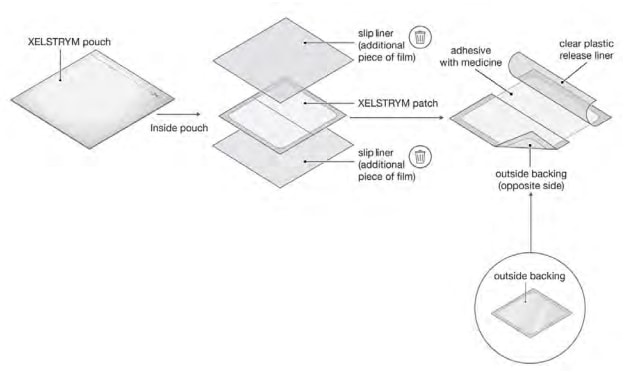
Figure A (not to scale).
Applying Xelstrym:
Step 1: Select the patch application site (see Figure B).
- Choose 1 application site, on either the left or right side, to apply 1 patch
- chest
- upper arm
- upper back
- flank (sides of the waist)
- hip
- Avoid areas of tight clothing, such as. waistbands or straps.
- Choose a different application site from the one used the previous day when you apply a new patch.
- Check the expiration date before applying the patch.
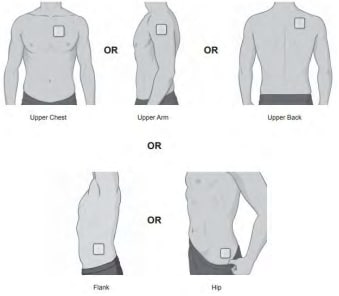
Figure B
Step 2: Check the skin where Xelstrym will be applied. Make sure it is:
- Not damaged (cut, scraped, burned), irritated (rashes), or has any other skin problems
- Dry (not wet) and clean, with no powder, oil, lotion, or gel
- Hairless or nearly hairless
If there is hair at the patch application site, do not shave the application site. Use scissors to clip hair as close to the skin as possible.
Step 3: Applying Xelstrym
- Carefully cut the pouch using scissors along the dashed line marked “Cut Here” (see Figure C).
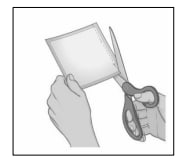
Figure C - Gently remove the contents of the pouch and throw away the additional pieces of film above and below the patch (see Figure A, Figure D).
- Do not use the patch if it is cut or damaged
- Apply the patch right away after removing it from the pouch
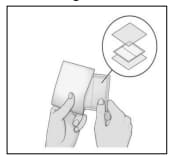
Figure D
- Gently peel away half of the clear plastic liner. Avoid touching the sticky side with your fingers (see Figure E).
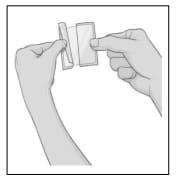
Figure E - Apply the sticky side of the patch to the application site you selected and smooth it down (see Figure F).
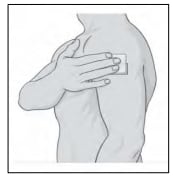
Figure F - Hold the edge of the remaining protective liner, slowly peel it off and smooth the patch down (see Figure G).
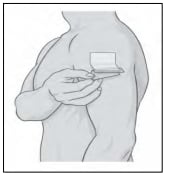
Figure G - Press the patch firmly with the palm of your hand.
- Smooth the patch to make sure it sticks well to your skin (See Figure H).
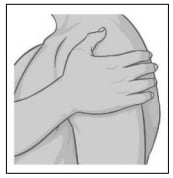
Figure H
Xelstrym patch should not be applied or reapplied with dressings, tape, or other adhesives. - Wash your hands with soap and water after applying the patch (see Figure I).
Hand sanitizer should not be used in place of soap and water.
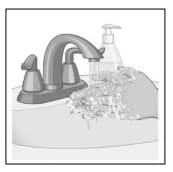
Figure I
Step 4: Check Xelstrym regularly during the day to make sure it is completely sticking to the application site.
- Also check the patch when:
- using the bathroom
- undressing or changing clothes
- after sleeping
- if sweating a lot
- after bathing, showering or swimming
- If patch edges lift, smooth the patch down on the skin and press firmly with the palm of your hand. Xelstrym patch should not be reapplied with dressings, tape, or other adhesives.
- If the patch falls off, do not reapply the same patch. Fold the patch in half so that the sticky sides are together and throw away the patch as instructed below in Steps 5 to 7. You may apply a new patch to a different application site. The total wear time for the first patch that fell off and the second replacement patch should not be more than a total of 9 hours in 1 day (24 hours).
- Parents or caregivers of children prescribed Xelstrym should instruct the child to tell an adult if the patch becomes loose or falls off.
Xelstrym Application Schedule for 9 Hour Wear Time:
| If you put the patch on at: | On the same day, remove the patch no later than: |
| 6:00 a.m. | 3:00 p.m. |
| 7:00 a.m. | 4:00 p.m. |
| 8:00 a.m. | 5:00 p.m. |
| 9:00 a.m. | 6:00 p.m. |
| 10:00 a.m. | 7:00 p.m. |
| 11:00 a.m. | 8:00 p.m. |
| 12:00 p.m. | 9:00 p.m. |
Removing and Disposing Used Xelstrym:
Step 5: After 9 hours, remove Xelstrym and fold it in half so that the sticky sides stick together (see Figure J) to avoid accidental exposure to medicine.
- If any adhesive (glue) remains on your skin after you remove the patch, apply an oil based product or water and soap to the skin to remove the glue.
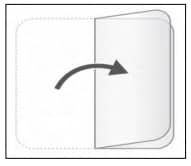
Figure J
Step 6: Throw away the used patch in a container with a lid right away (see Figure K).
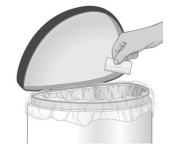
Figure K
Step 7: Wash your hands with soap and water after throwing the patch away (see Figure L).
Hand sanitizer should not be used in place of soap and water.
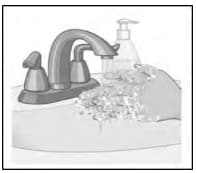
Figure L
Storing Xelstrym
- Store Xelstrym at room temperature between 68º F to 77ºF (20ºC to 25ºC).
- Store Xelstrym in a safe place, like a locked cabinet.
- Protect Xelstrym from light and moisture.
- Keep Xelstrym in their unopened pouches until you are ready to use them.
- Keep Xelstrym and all medicines out of the reach of children.
Disposing of unused Xelstrym:
Dispose of remaining unused or expired Xelstrym by a medication take-back program at authorized collection sites such as retail pharmacies, hospital or clinic pharmacies, and law enforcement locations. If no take-back program or authorized collector is available, each unused patch should be removed from its individual pouch, separated from the protective liner, folded in half, and disposed of in the same manner as used patches.
Instructions for use approved 03/2022.




